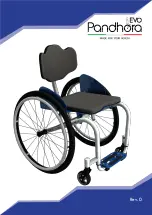
Fi
t a
n
d u
se
14
15
Retractable tie-downs
Retractable tie-downs
1.
The third point anchorage, (Fig. 9B shown as example) will have been installed
in accordance with our own and the vehicle converter’s instruction.
2. Once retractors have been installed, connect tongue, (Fig. 9A) to buckle, (Fig.
9B) and check the free running of the webbing into and out of the inertia reel,
and check the ’lock up’ facility of the reel by engaging a short tug at various
intervals along the extension and retraction of the webbing in and out of the
reel.
3. Draw the running tongue, (Fig. 9C) across the occupant, through the furthest
arm of the wheelchair and connect to the wheelchair retractor’s buckle, (Fig.
9D).
4. Pass the running buckle, (Fig. 9E) through the near arm of the wheelchair
and connect it to the belt’s tongue, (Fig. 9F) forming the complete lap and
diagonal. The lap belt anchor points should be positioned to achieve belt
angles of 30° or more to the horizontal, and preferably between 45° and 75°
in order to fit low across the pelvis, reducing the possibility of the belt loading
the abdoment, (Fig. 8).
5. The pelvis restraint is designed to bear upon the bony structure of the body
and should be worn low across the front of the pelvis with any junctions
between the pelvic and shoulder restraints located near the wearer’s hips.
Removing the 3rd point WAV
occupant restraint belt
1.
Unfasten the buckles, remove
the occupant restraint and let the
webbing retract back into the
housing.
Fit and use
3 point WAV occupant restraint belt
Bolted
Figure 9
B
C
F
E
A
D
Figure 8
Rear
securement
points
Wheelchair
reference
plane
45°
30°
SIDE VIEW
REAR VIEW
10°
10°
300mm
(12in)
NOTE Note that angles indicated are obtained by projecting the angle of each tie-down strap
onto a vertical plane parallel to the wheelchair reference plane (side view) or onto a vertical
plane that is perpendicular to the wheelchair reference plane (rear view).






































